Mark J. Stock: Turbulance_Infinite_P21C
Artist(s):
Title:
- Turbulance_Infinite_P21C
Exhibition:
- SIGGRAPH 2003: CG03: Computer Graphics 2003
-
More artworks from SIGGRAPH 2003:


Creation Year:
- 2003
Size:
- 48 in x 24 in
Category:
Artist Statement:
I enjoy using computer simulations of natural and artificial phenomena to visualize patterns created from either the isolation of a particular dominant force or the interplay between co-dominant forces. An advantage of working with computer models for these physical systems is the availability of data for any component of the system: effectors or inerts can be made visible, temporal; spatial dimensions can be swapped; and non-physical projections of data can be created. New patterns can be explored by nearly any combination of forces or projections. The aim of my work is the creative exploration of this space.
In these pieces, I attempt to illustrate the unseen depth and complexity of fluid turbulence and the difficulty in recreating its effects on a computer. Though it is an essential physical phenomenon, humans are surprisingly ill-equipped to visualize the structure or grasp the sheer ubiquity of turbulence. My choice to instantiate the transient vortex cores as solid cylinders is an attempt to understand their structure as well as to conceptualize their depth. Creating a feeling of depth and realism requires not only a computationally intensive inter-reflection calculation, but also extreme detail, using not textures, but real geometry.
In these simulations, turbulence is represented by segments of a long line, each segment representing the mathematical “vortex core” of a local packet of fluid. In this way, a turbulent flow can be represented more compactly by its vorticity, and not its velocity. The motions that evolve these vortex lines are a product of computer simulations of vorticity dynamics. In vorticity dynamics, each segment of each vortex line induces motion in every other segment in the simulation. The schemes designed to make this sort of calculation computationally tractable are called vortex methods.
Ultimately, each image is a photometrically accurate computer rendering of a tangle of these vortex lines. Special oversampling and filtering operations are performed in order to create the most detailed image possible. This image is then output to a Lightjet digital printer, which exposes photographic paper with a laser after internally upsampling the image to 4,000 dpi.
All Works by the Artist(s) in This Archive:
- Mark J. Stock
-

Open House
[SIGGRAPH 2006] -
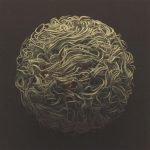
Dynamo
[SIGGRAPH 2007] -
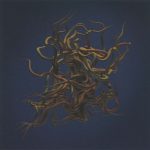
Green Streamlines
[SIGGRAPH 2007] -
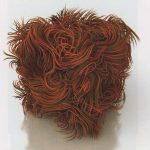
Red streamlines
[SIGGRAPH 2004] -
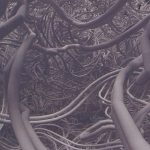
Turbulance_Infinite_P21C
[SIGGRAPH 2003] -
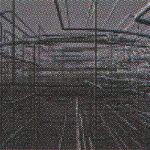
Refinery #53, Mesh #3 Iso
[SIGGRAPH 2002] -

Four Mountains
[SIGGRAPH 2013] -
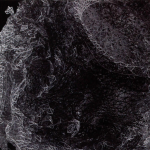
Smoke Water Fire
[SIGGRAPH 2008] -
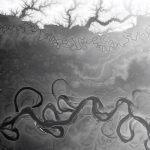
MESO
[DAC Online Exhibition 2016] -
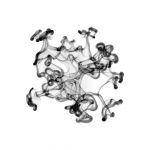
Chaotic Escape
[DAC Online Exhibition 2016]




